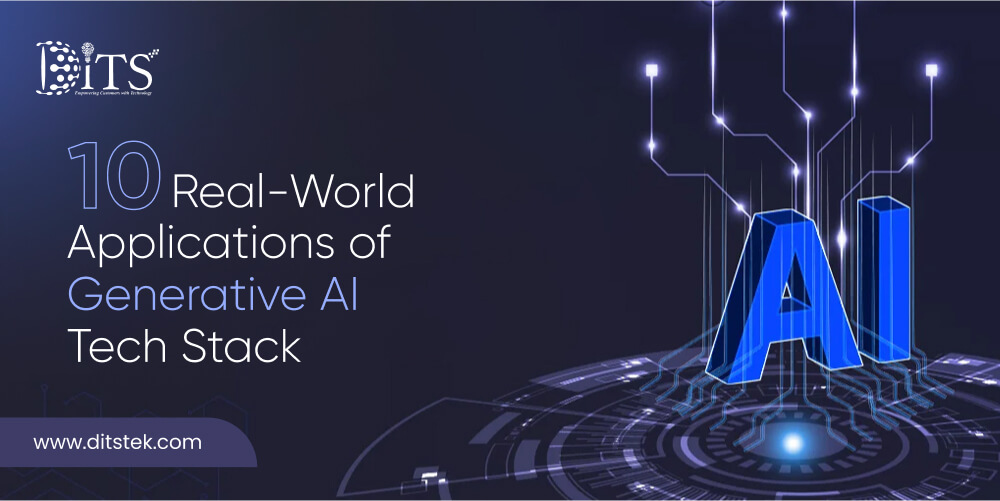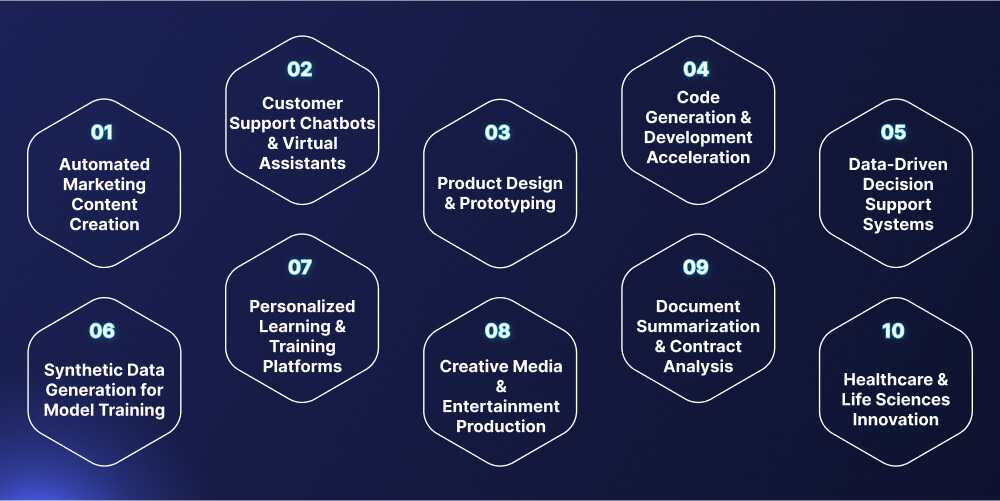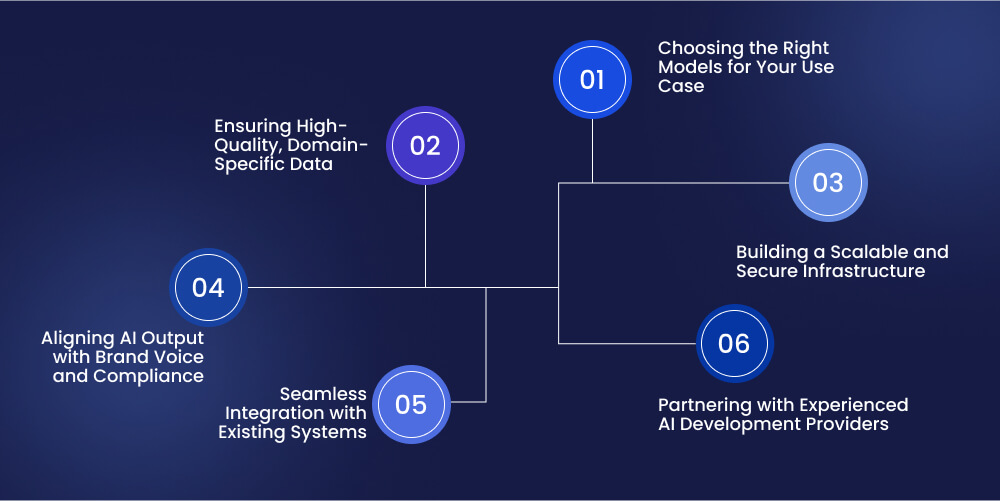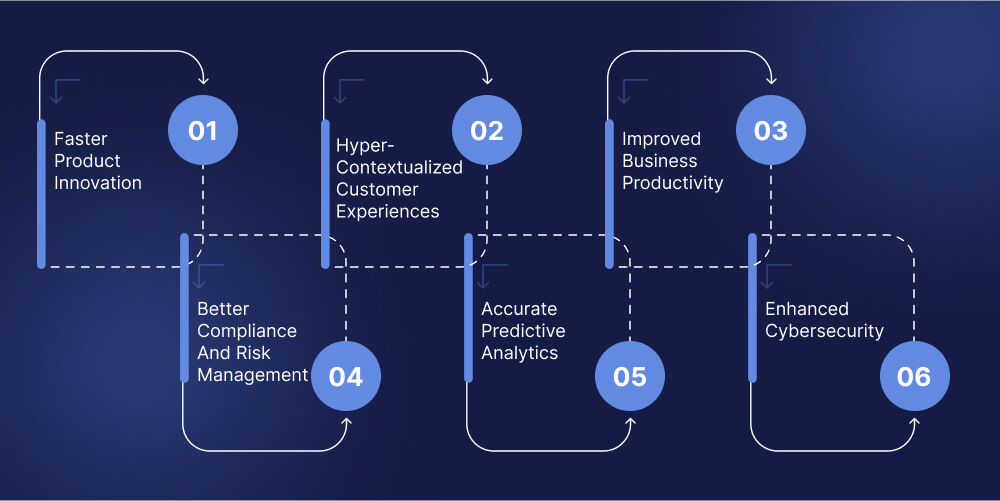10 Real-World Applications of Generative AI Tech Stack
Ditstek Blogs
Generative AI has emerged as one of the most disruptive and influential technologies of recent years, with applications spanning industries from healthcare to gaming, manufacturing to marketing. While traditional AI and machine learning systems identify patterns in data to provide insights, generative AI goes a step further by creating new data as its primary output.
Generative AI can deliver a whole speech from just a few keywords, generating music, art, or images from text descriptions, or develop a business strategy through interactive conversations with back-and-forth “prompting.” At the heart of this transformation is the AI tech stack, the foundational set of tools, platforms, and methodologies that make these advancements possible.
The commercial potential of generative AI is only beginning to be realized, making the possibilities for its future virtually limitless. For businesses, the key to unlocking this potential lies in building a robust generative AI tech stack, a carefully chosen combination of frameworks, infrastructure, and integration capabilities tailored to specific goals. This blog shares the real-world applications of generative AI in tech stack and factors that impact its successful implementation.
Is Your Tech Stack AI-Ready?
Without the right foundation, generative AI remains theory. Learn how your business can move from experiments to enterprise-grade impact.
Understanding the AI Tech Stack
An AI tech stack is a tailored combination of software tools, frameworks, cloud platforms, and methodologies that organizations use to design, train, deploy, and manage AI-driven solutions. Unlike traditional software stacks, an AI-focused stack supports complex workflows like large-scale data processing, model training, prompt engineering, and inference optimization.
A well-designed generative AI tech stack enables:
- Faster development cycles for innovative applications.
- High accuracy, scalability, and reliability in AI models.
- Seamless integration into business processes.
In industries as varied as real estate, healthcare, design, marketing, and education, the right tech stack transforms AI concepts into production-ready, business-impacting solutions.
Real-World Applications of a Well-Built Generative AI Tech Stack

A well-structured generative AI tech stack is not just a collection of tools, but a foundation that enables businesses to innovate faster, scale efficiently, and deliver personalized experiences at a fraction of the traditional cost. Below are ten real-world applications where companies are already gaining measurable value.
1. Automated Marketing Content Creation
Generative AI can produce high-quality marketing copy, product descriptions, and ad creatives in minutes, all tailored to specific audience segments. This enables brands to launch campaigns faster and maintain a consistent voice across channels. Retailers, for instance, are automating seasonal promotions and personalizing offers at scale.
2. Customer Support Chatbots & Virtual Assistants
Advanced conversational AI, built on strong generative AI tech stack components, powers AI chatbots capable of providing accurate, 24/7 responses. These bots retain conversation context, making interactions smooth and human-like. Banks and telecom providers are using this to reduce call center workloads while improving customer service and satisfaction.
3. Product Design & Prototyping
Generative AI accelerates the product design process by creating realistic mockups and 3D models in record time. From automotive companies testing digital prototypes to fashion brands designing new collections, AI is redefining creative workflows.
4. Code Generation & Development Acceleration
With AI-powered coding tools, businesses can generate, debug, and optimize code faster than ever. At DITS, we integrate AI into every project for custom software development, improving efficiency in software engineering, testing, and deployment. This approach ensures that every solution we deliver meets performance, scalability, and security goals.
5. Data-Driven Decision Support Systems
Businesses use generative AI to simulate market scenarios, forecast sales, and evaluate risks in real time. These AI-powered insights enable leaders and business managers to make precise, data-backed decisions with greater confidence.
6. Synthetic Data Generation for Model Training
In industries where privacy and compliance are critical, such as healthcare, AI can generate synthetic datasets to train models without exposing sensitive information. This is especially useful in generative AI use cases in healthcare, such as predictive diagnostics.
7. Personalized Learning & Training Platforms
E-learning providers are using AI to create tailored learning experiences based on a user’s pace, preferences, and skill level. This includes auto-generating quizzes, tutorials, and multimedia-rich training modules for corporate teams.
8. Creative Media & Entertainment Production
From generating background scores for films to designing game environments, AI is making creative production faster and more cost-effective. Studios are also using AI to test audience reactions to scripts and storylines before investing in full-scale production.
9. Document Summarization & Contract Analysis
Legal firms and real estate companies are deploying AI to review and summarize lengthy documents, flagging risks and extracting critical terms in seconds. This reduces manual review times and boosts operational efficiency.
10. Healthcare & Life Sciences Innovation
Generative AI also plays a vital role in discovery of drugs and medicines in the pharmaceutical industry. The key role of generative AI in drug discovery is simulating molecular structures and identifying potential treatments faster than traditional methods. Pharmaceutical companies are cutting R&D timelines by years with these advancements.
Struggling With Scaling AI Projects?
Many businesses stall after pilot programs. A robust generative AI tech stack ensures scalability, security, and compliance for real-world deployment.
Factors That Determine Success in Generative AI Implementation

While the potential of a generative AI tech stack is immense, success depends on how well it is planned, built, and integrated into existing business ecosystems. The following factors can determine whether your AI investment delivers measurable ROI or falls short of expectations.
1. Choosing the Right Models for Your Use Case
Not all AI models are created equal. Selecting the right architecture, whether transformer-based language models, diffusion models for images, or specialized domain models, is essential to align the solution with business objectives and industry standards.
2. Ensuring High-Quality, Domain-Specific Data
Generative AI is only as good as the data it is trained on. Clean, relevant, and well-structured datasets enable accurate and contextually appropriate outputs, reducing the risk of bias and errors. AI experts need to feed the generative AI with accurate and verified data to ensure that AI gets trained with precise, high-quality data.
3. Building a Scalable and Secure Infrastructure
Any tech stack for generative AI should be designed for growth, with scalable cloud infrastructure, containerized deployments, and robust security measures to safeguard intellectual property and sensitive business data.
4. Aligning AI Output with Brand Voice and Compliance
Businesses must ensure that AI-generated content matches their brand’s tone and adheres to industry regulations. This is particularly critical in regulated sectors like finance and healthcare, where non-compliance can have severe consequences.
5. Seamless Integration with Existing Systems
Partnering with experts in Generative AI Integration Services ensures the AI solution works harmoniously with current software, CRM, ERP, and workflow tools, avoiding costly disruptions in business operations.
6. Partnering with Experienced AI Development Providers
Working with a trusted provider like DITS gives you access to deep expertise in AI software development, rigorous quality assurance, and AI-driven customization. We integrate AI into every software solution we build, ensuring businesses maximize both immediate impact and long-term scalability.
Benefits of Generative AI for Businesses

Generative AI is more than a creative tool, it’s a strategic business enabler. Below are six key ways it can deliver value:
1. Faster Product Innovation
By automatically generating code and other assets, generative AI can dramatically speed up development timelines. Businesses can launch innovative software, data products, or features faster, cutting operational costs and gaining a competitive edge.
2. Hyper-Contextualized Customer Experiences
Generative AI enhances analytics and recommendation engines to deeply understand customer preferences, behaviors, and intent. This allows for more relevant and authentic interactions, improving engagement and brand loyalty.
3. Improved Business Productivity
Knowledge workers often spend up to 20% of their time finding and collecting information. With generative AI tech stack, vast datasets can be queried and summarized in plain language, enabling faster insights and decision-making.
4. Better Compliance and Risk Management
The technology can continuously monitor data streams, detect anomalies, and flag potential compliance issues before they escalate. This helps organizations proactively prevent fraud and mitigate risks.
5. Accurate Predictive Analytics
Generative AI models can forecast demand, optimize supply chains, and improve medical outcomes. In healthcare, for instance, AI can identify patients at high risk for heart failure, enabling earlier interventions.
6. Enhanced Cybersecurity
By analyzing network activity and detecting anomalies, generative AI can identify malware, detect evolving threats, and anonymize sensitive data, strengthening both security and privacy compliance.
Ready to Lead in the AI Era?
The businesses that act now will define tomorrow. Don’t wait—equip your organization with a future-ready generative AI tech stack today.
Why Choose DITS for Generative AI?
At DITS, we specialize in delivering end-to-end AI-powered solutions, combining custom software development expertise with generative AI software development services. Our expertise goes beyond deploying AI tools; we build robust, future-ready solutions tailored to your industry and business goals.
We integrate AI into every stage of our process, from coding and quality assurance to feature customization, ensuring that every project is built for performance, scalability, and competitive advantage. By leveraging a well-structured generative AI tech stack, we integrate AI into every stage of development, from coding and quality assurance to customization and system integration.
With a strong focus on performance, security, and compliance, we ensure your AI investments deliver measurable ROI, empowering your organization to stay ahead in today’s AI-driven business environment.
Conclusion
Generative AI is a proven business accelerator capable of transforming industries. With a strategically built generative AI tech stack, organizations can unlock efficiencies, create innovative products, and deliver personalized experiences at scale. From automating marketing workflows to advancing drug discovery, its applications are as diverse as they are impactful.
The future of AI-driven innovation belongs to businesses that act now. With the right strategy, technology, and partner, you can leverage AI to reimagine your workflows, products, and customer experiences, positioning your business at the forefront of a fast evolving AI world.
FAQs
1. What is the tech stack for generative AI?
A tech stack for generative AI is the combination of tools, frameworks, cloud services, and integration layers used to build, train, and deploy generative AI applications. It typically includes machine learning frameworks (like TensorFlow or PyTorch), large language models (LLMs), GPU/TPU infrastructure, and APIs for integration.
2. Which technology is used for generative AI?
Generative AI solutions use advanced machine learning architectures such as transformer models (e.g., GPT, BERT), diffusion models for image generation, and reinforcement learning for optimization. These run on high-performance computing infrastructure with specialized hardware like NVIDIA GPUs or Google TPUs.
3. Why is the AI tech stack important for generative AI projects?
A proper AI tech stack ensures that generative AI solutions are scalable, accurate, reliable, and can be efficiently developed and deployed.
4. Which industries benefit most from generative AI?
Industries such as healthcare, manufacturing, marketing, education, and gaming are among the top adopters due to the technology’s versatility.
5. Can generative AI help reduce operational costs?
Yes. By automating content generation, code development, and data analysis, generative AI reduces labor-intensive processes and speeds up workflows.
6. How can a well-built generative AI tech stack benefit my business?
A well-built generative AI tech stack enables faster innovation, streamlined workflows, and personalized customer experiences. For example, it can automate marketing content, accelerate product design, improve customer service, and enhance decision-making, directly impacting revenue and operational efficiency.
7. What are the most important components to include in a tech stack for generative AI?
Key generative AI tech stack components include model architectures (e.g., GPT, diffusion models), secure data pipelines, scalable cloud infrastructure, compliance layers, and integration APIs. The right combination depends on your business goals and industry regulations.
8. Can generative AI be customized for my specific industry needs?
Yes. With Generative AI Integration Services, AI models can be fine-tuned using your industry data, brand voice, and compliance requirements. This ensures outputs are relevant, accurate, and aligned with your operational objectives.
9. How does DITS use AI in software development?
At DITS, we integrate AI into every stage of our AI software development process, including coding, quality assurance, maintaining code quality, and customizing solutions. This ensures every project is optimized for performance, scalability, and future AI advancements.
10. What is the role of generative AI in healthcare and life sciences?
In healthcare, generative AI use cases in healthcare include medical image generation, predictive diagnostics, and patient engagement tools. Its role in drug discovery is particularly impactful, AI can simulate molecular structures and identify potential drug candidates faster, reducing R&D timelines.

Dinesh Thakur
21+ years of IT software development experience in different domains like Business Automation, Healthcare, Retail, Workflow automation, Transportation and logistics, Compliance, Risk Mitigation, POS, etc. Hands-on experience in dealing with overseas clients and providing them with an apt solution to their business needs.
Recent Posts
Get in touch










 Calgary | Edmonton | Vancouver | Toronto
Calgary | Edmonton | Vancouver | Toronto Marriott Downtown Hotel | Calgary
Marriott Downtown Hotel | Calgary